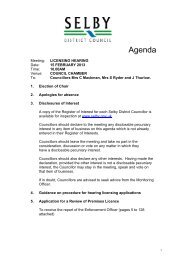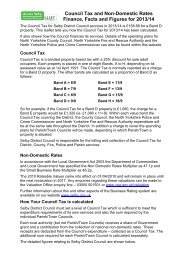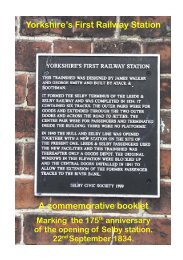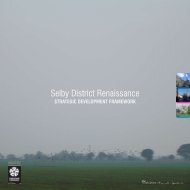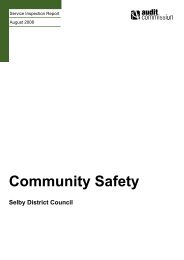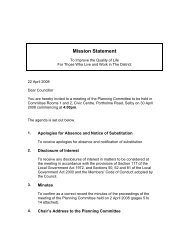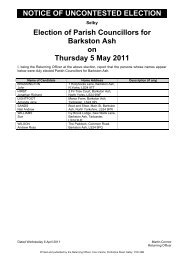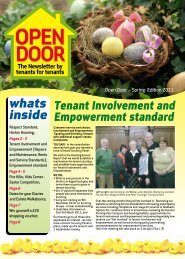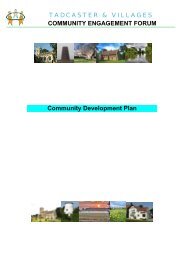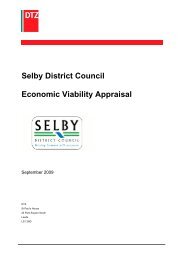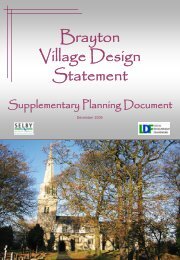Tracked Version of Core Strategy, November 2012 - Selby District ...
Tracked Version of Core Strategy, November 2012 - Selby District ...
Tracked Version of Core Strategy, November 2012 - Selby District ...
Create successful ePaper yourself
Turn your PDF publications into a flip-book with our unique Google optimized e-Paper software.
<strong>Selby</strong> <strong>District</strong> Submission Draft <strong>Core</strong> <strong>Strategy</strong> – May 2011<br />
_________________________________________________________________<br />
2.2 Life in the <strong>District</strong> is strongly influenced by the adjacent larger urban<br />
areas, particularly Leeds and York. The 2001 census reveals that<br />
approximately half <strong>of</strong> the working population commute outside the<br />
<strong>District</strong>, and the latest evidence from the Council’s 2009 Strategic<br />
Housing Market Assessment 1 suggests that this proportion has<br />
increased further to around 59%.<br />
Figure 4<br />
Key Population Facts<br />
• Total population approx 82,200<br />
• 40,250 males (49%) and 41,950 females (51%)<br />
• White people make up 97.7% <strong>of</strong> the population with BME<br />
about 2.4%<br />
• Working age population 50,600 (61.5%)<br />
• 33.7% aged 25-49.<br />
• 19.5% aged 65+<br />
• Only 10.3% in 16-24 age groups.<br />
2.3 Much <strong>of</strong> the <strong>District</strong> is relatively flat and low-lying, and is characterised<br />
by open, sparsely wooded arable landscapes including extensive<br />
areas <strong>of</strong> the highest quality agricultural land. More sensitive higher<br />
quality landscape is generally confined to the limestone ridge, which<br />
runs north-south along the western side <strong>of</strong> the <strong>District</strong>.<br />
2.4 In terms <strong>of</strong> the historical environment, although <strong>Selby</strong> <strong>District</strong> has one<br />
<strong>of</strong> the lowest densities and overall total <strong>of</strong> designated assets in the<br />
region there are known to be significant archaeological remains along<br />
both the Southern Magnesian Limestone Ridge and within the<br />
Humberhead Levels. Medieval sites, particularly moated and manorial<br />
sites are a feature <strong>of</strong> the <strong>District</strong> including Scheduled Monuments such<br />
as the important Newton Kyme Henge. Skipwith Common is a<br />
significant resource for both biodiversity and archaeology. The Roman<br />
heritage <strong>of</strong> Tadcaster is particularly significant. The <strong>District</strong> has a<br />
significant ecclesiastical history including <strong>Selby</strong> Abbey, Cawood Castle<br />
and the Bishops Canal (now known as Bishop Dike). The 19 th century<br />
farming heritage <strong>of</strong> the <strong>District</strong> provides an important record <strong>of</strong> the<br />
intensification <strong>of</strong> production and is illustrated most strongly in the<br />
impressive dairy buildings on many larger holdings. 20 th century<br />
military remains are also a key feature <strong>of</strong> the <strong>District</strong>’s historic<br />
environment, most notably the current and former airfields and<br />
associated buildings.<br />
2.5 The <strong>District</strong> also has a wealth <strong>of</strong> natural features and wildlife habitats,<br />
1 http://www.selby.gov.uk/upload/<strong>Selby</strong>_SHMA_FINAL_REPORT_090618.doc<br />
- 13 -



